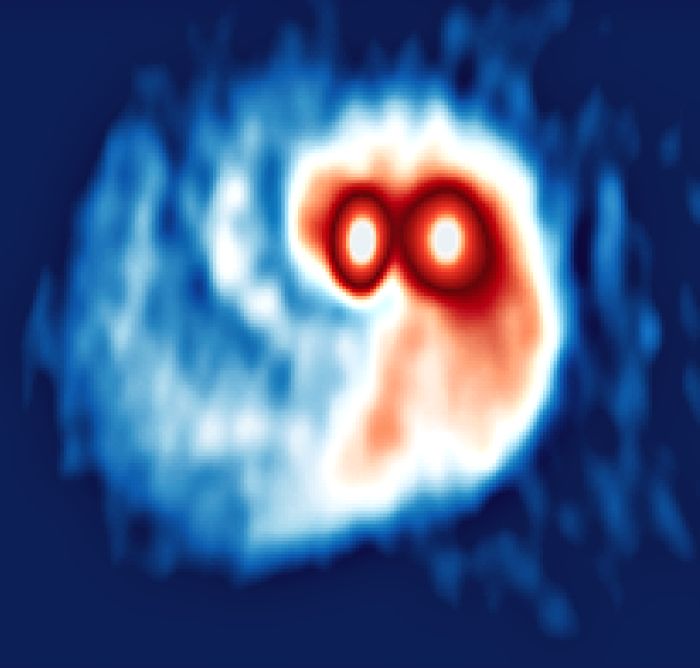Astronomers have spied three whole systems of exoplanets being born around one binary star.
SVS 13 is a binary star system 980 light-years away, and the complex structures of dust around it are shedding light on how planetary systems are born in these fascinating environments. Since a large proportion of stars is bound up in multiple-star systems, this has implications for our understanding of planet formation and evolution.
“Our results have revealed that each star has a disk of gas and dust around it and that, in addition, a larger disk is forming around both stars,” says astronomer Ana Karla Díaz-Rodríguez of the Institute of Astrophysics of Andalusia (IAA-CSIC) in Spain and the ALMA Regional Centre at the University of Manchester in the UK.
“This outer disk shows a spiral structure that is feeding matter into the individual disks, and in all of them planetary systems could form in the future. This is clear evidence for the presence of disks around both stars and the existence of a common disk in a binary system.”
Stars are born from dense knots in clouds of molecular gas floating in space. Under the right conditions, one of these knots will collapse under its own gravity and start spinning. As it spins, the material around it flattens into a disk that spools into the star, feeding its growth.
When the star reaches the end of its formation, whatever is left becomes the protoplanetary disk. All the leftover dust and gas jostles around, and eventually comes together in big enough clumps that build up to form planets, asteroids, comets, moons, dwarf planets and all the other chunky fun you can find in a planetary system.
We know this occurs around single stars pretty readily; the Solar System alone is proof that it can happen, and most of the exoplanets confirmed to date have been found orbiting single stars. It’s thought that a system of multiple stars, creating an environment that is more gravitationally complicated, might be more hostile to the planet formation process.
 ALMA image of the disks in SVS 13. (Díaz-Rodríguez et al.)
ALMA image of the disks in SVS 13. (Díaz-Rodríguez et al.)
SVS 13 is relatively close, in a star-forming cloud called the Perseus molecular cloud, and very young. It consists of two stars with a combined mass about equal to that of the Sun, locked in a very tight orbit; they are only about 90 astronomical units apart (Pluto is about 40 astronomical units from the Sun).
To learn more about the space around this binary protostar, as well as the stars themselves, Díaz-Rodríguez and her team studied 30 years of observations from the National Radio Astronomy Observatory’s Very Large Array. They also took new observations with the Atacama Large Millimeter/submillimeter Array, known as ALMA.
This allowed the team to reconstruct the binary’s orbit, and determine the masses of the stars, the orientation of the system, and the sizes and masses of the disks. They found two small disks, one with a dust radius of 12 astronomical units, and the other with a dust radius of 9 astronomical units, both with a gas radius of 30 astronomical units.
The huge spiral circumbinary disk, enclosing both stars, has spiral arms that extend 500 astronomical units.
“At the IAA we began studying this system twenty-five years ago. We were surprised when we discovered that SVS 13 was a radio binary, because only one star is seen in the optical,” said astronomer Guillem Anglada of IAA-CSIC.
“It was very strange to discover a pair of twin stars where one of them seemed to have evolved much faster than the other. We designed several experiments to get more details and to find out if in such a case either of the stars could form planets. Now we have seen that both stars are very young, and that both can form planets.”
There are more reasons to be interested in the system than resolving the debates around the ages of the two stars. Previous studies of the system identified molecules in the dust and gas around the SVS 13, including complex organic molecules that are precursors to the building blocks of life.
“This means that when planets begin to form around these two suns,” Díaz-Rodríguez said, “the building blocks of life will be there.”
We might not be around to see the process unfold, but knowing that those molecules are there may help us unravel the mystery of our existence in the Universe.
The research has been accepted by The Astrophysical Journal, and is available on preprint server arXiv.
